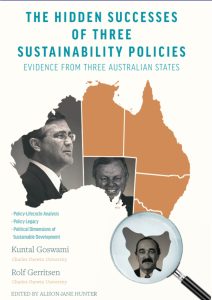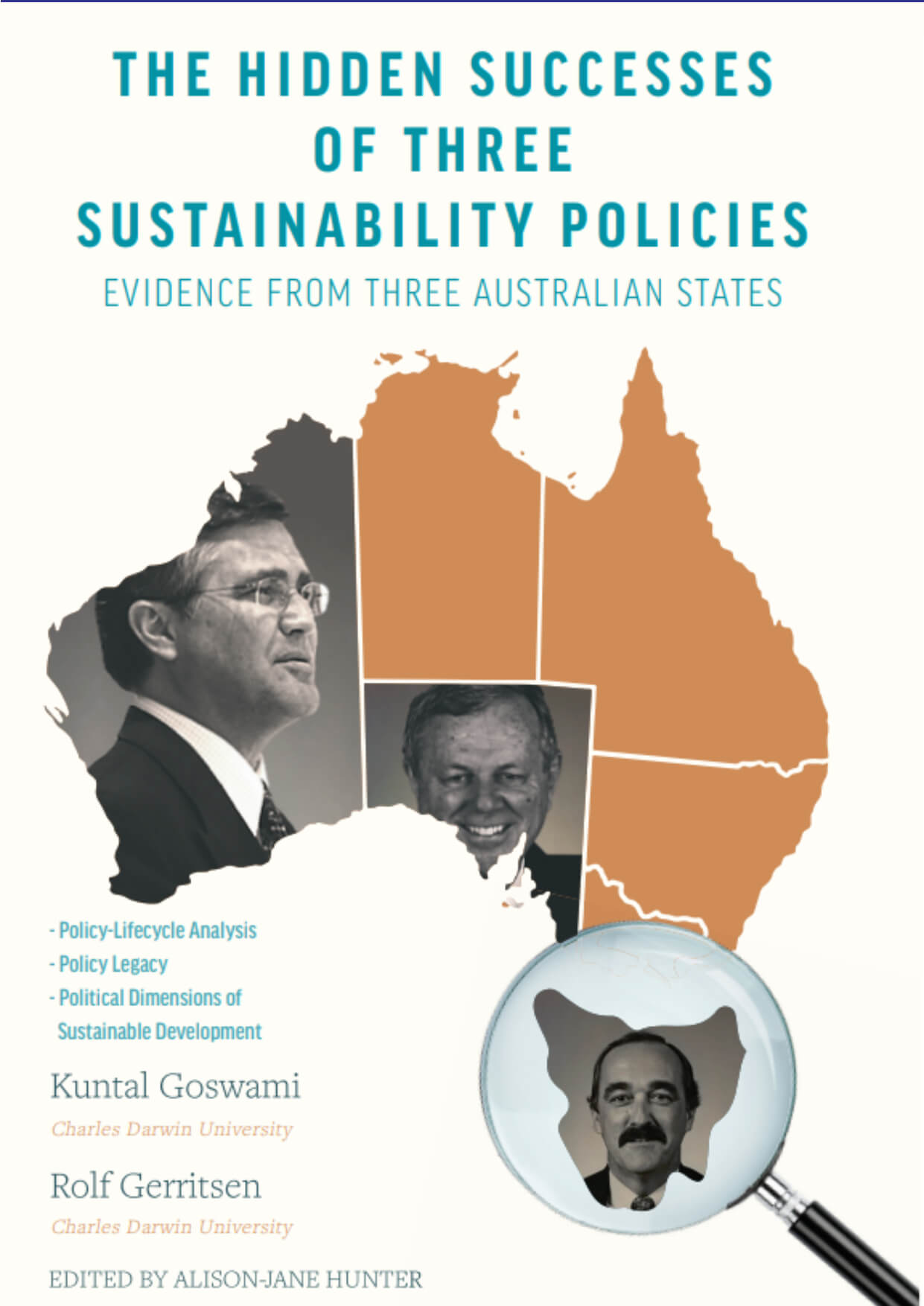Books
The Hidden Successes of Three Sustainability Policies : Evidence from Three Australian States

Subheading: Hidden Success of Australian Sustainability Public Policies
Australian Sustainability Policies
Tasmania Together,
South Australia’s Strategic Plan,
Western Australian State Sustainability Strategy
Policy-Lifecycle Analysis
Policy Legacy
Political Dimensions of Sustainable Development
- Public Policies
Authors: Dr Kuntal Goswami, Charles Darwin University, and Prof. Rolf Gerritsen, Charles Darwin University
Edited by Alison-Jane Hunter, University of Adelaide
Citation: Goswami, K. and Gerritsen, R. (2021), ‘The Hidden Successes of Three Sustainability Policies – Evidence from Three Australian States’, (eds) Hunter, A.J., ACSDRI-Knowledge Press & Green Hill Academic, Adelaide, South Australia. ISBN: 978-0-6452550-0-3 & 978-0-6452550-1-0 https://acsdri.com/publications-on-sustainable-development/australian-sustainability-policies/
Acknowledgment
We take this opportunity to thank Emeritus Professor Geoffery Gallop, University of Sydney, and Associate Professor Kate Crowley, University of Tasmania, for writing the Forewords. We would also like to thank all the interview participants and the organizations that have helped us execute this research project.
We sincerely thank Dr. Alison-Jane Hunter for editing our book. Finally, we thank our family and friends for their moral support, love, and encouragement.
Testimonials
“In The Hidden Successes of Three Sustainability Policies, Goswami and Gerritsen start with the international and national context… they demonstrate that the idea of sustainability can, if only gradually, impact the decision-making culture of an organization if given sufficient support from “above.” Sustainability is an idea searching for a leader; it has its terms and conditions for success…
The material the authors gather to reach their conclusions is impressive – and presented with clarity and precision… After all, it is one thing to develop relevant and feasible policies but quite another to ensure their acceptability. It is a strength of The Hidden Successes that it incorporates politics and legitimacy questions into the analysis, not to make a case against sustainability but rather to remind us, as is the case with all public policy, that material interests, professional prejudices, and ideological warriors are all at the table making life difficult for those seeking a long term, strategic approach to government.”
Emeritus Professor Geoffery Gallop,
University of Sydney
Ex-Member of the Western Australia Legislative Assembly (1986-2006);
Ex-Premier of Western Australia (2001-2006)
“Indeed, as The Hidden Successes of Three Sustainability Policies shows, through detailed empirical analysis, sustainability culture has become deeply ingrained within Australian policy and practice at the State level… The Hidden Successes of Three Sustainability Policies details their sustainability reports, with policy championing, implementation, evaluation, learning, and adaptive governance prominent in its analysis…
The Hidden Successes of Three Sustainability Policies concludes that subnational governments will persist in pursuing sustainability where federal governments fail.”
Associate Professor Kate Crowley
Public and Environmental Policy,
University of Tasmania
Preface
This book provides a practical demonstration of policymaking and policy lifecycle analysis. In order to accomplish these objectives, we have used three Australian state-level policies, Tasmania Together, South Australia’s Strategic Plan, and the Western Australian State Sustainability Strategy, as case studies.
We all hear about a government policy or scheme when it is formally announced in the newspaper or on television. However, we need to know where the initial idea comes from and how and why the idea is transformed into a formal political agenda. These are some of the critical questions we need to understand in policymaking. Equally important is to explore how and why a policy loses its relevance.
This book answers these behind-the-scenes questions. It provides a framework to investigate the life cycle of public policy and a multi-disciplinary approach to understand the level of commitment towards holistic sustainability (environment, economic, and social). This makes the book unique and unconventional, and therefore, it can be used as a practical guide for research students, academics, and public policy practitioners.
The book investigates every stage of these three selected case studies to understand the steps involved in policymaking and the reasons for policy redundancy. All discourses are substantiated using various sources, including interviews with relevant stakeholders. A public policy is like a product with a shelf life. However, the success of a policy lies in its commitment and legacy. The book also outlines a process to analyze public agencies’ internal commitment to the sustainability agenda.
In addition to providing practical illustrations of policy analysis, this book also presents an overview of how the sustainable development agenda is disseminated and incorporated into the public policy domain. Each selected policy had a role in advancing the sustainable development agenda in the political domain.
Overall, the book is bold and informative, addresses both the national and international contexts, and uses parliamentary discussions, budget, public agency’s annual reports, stakeholders’ comments, and other statistical data to seek answers to the question of impact. It also provides clarity and precision through relevant diagrams and tables summarizing the text.
This empirical research also demonstrates that sustainability can, if only gradually, positively impact the decision-making culture of an organization if sufficient support from policy champions is given. We reaffirmed this point in our postscript chapter.
Finally, the book reveals that institutional factors may facilitate the diffusion of a sustainable development value-based policy model. However, the actual implementation of the policy framework depends on fortuitous political and economic factors. Hence, the book highlights the relevance of understanding and analyzing the political dimension of sustainable development.
Content List
• Forewords
• Preface
Chapter 1 Introduction
- 1.1 Context
- 1 1.2 Brief overviews of the research
- 1.2.1 Application of the GRI’s SSPA Framework
- 1.3 Brief overview of the three selected states
Chapter 2 Sustainable Development- Centric Policies
- 2.1 Evolution of sustainable development
- 2.2 An overview of sustainable development centric policies
- 2.2.1 International perspectives
- 2.2.2 Australian context
- 2.2.3 Australian sub-national context
Chapter 3 Case Study 1: Tasmania Together: A Policy model to Reconnect
- 3.1 Background
- 3.2 Policy Lifecycle of Tasmania Together
- 3.2.1 Contextual Influence of Tasmania Together
- 3.2.2 Policy Learning Process
- 3.2.3 Policy adaptation process
- 3.2.4 About Tasmania Together (TT)
- 3.2.5 Policy effectiveness: stakeholders’ perspectives
- 3.2.6 Tasmania Together’s abolition process
- 3.3.Tasmania Together: Budget Perspective
- 3.4 Conclusion
Chapter 4 Case Study 2: South Australia’s Strategic Plan – A Policy Tool to Reposition the Government’s Image
- 4.1 Background
- 4.2 Policy learning and adaptation process
- 4.3 About South Australia’s Strategic Plan (SASP)SASP)
- 4.4 Policy effectiveness: stakeholders’ perspectives
- 4.5 The SASP’s abandonment process and budget perspective
- 4.6 Conclusion
Chapter 5 Case Study 3: Western Australia’s State Sustainability Strategy: An Aspirational Policy Vision
- 5.1 Background
- 5.2 The policy champions
- 5.3 Policy adoption and the shelving process
- 5.4 About WA’s State Sustainability Strategy (SSS)
- 5.5 Policy evaluation: stakeholders’ perspectives
- 5.6 Conclusion
Chapter 6 Policymaking Process, Commitment & Impact 6.1 The Policymaking process
- 6.2 Commitment towards policy
- 6.2.1 Commitment: Budgetary Allocation Perspective
- 6.2.1.1 Tasmania
- 6.2.1.2 South Australia
- 6.2.1.3 Western Australia
- 6.2.1.4 Summary of Budgetary Trends Analysis
- 6.3 Policy impact
- 6.3.1 Selected economic indicators from the MAP data set
- 6.3.2 Selected social indicators from the MAP data set
- 6.3.3 Selected environmental indicators from the MAP data set
- 6.4 Learning and Insights
Chapter 7 Conclusion: The Political Dimension of Sustainable Development
- 7.1 An overview
- 7.2 Political implications of the three selected policies
Chapter 8 Postscript
- 8.1 Postscript
References
Glimpses of Chapter 1 Introduction
1.1 Context
Public policy is the political offspring of specific political processes, movements, values, or ideologies. Every policy is drafted with an agenda to bring about change. However, every policy has a political shelf-life, no matter how great its objectives. Generally, a policy’s shelf-life is linked to its champion’s political fortunes or the political entity that drafted it. At the same time, the success of a policy can be judged by its commitment and policy legacy.
Furthermore, public policy is not ‘born out of the blue’. Instead, it is born out of a political, economic, social, and environmental context that leads to the drafting of the policy. A policy also goes through different phases of relevance in its life cycle before it loses its shelf-life.
Hence, this book provides an analytical policymaking perspective by systematically investigating three Australian state-level public policies of the early 2000s. In Australia, between 1998 and the first half of the 2000s, all Labor Party-governed states adopted holistic-sustainability (environmental, economic, and social) value-based strategic plans or strategies. Through this new policy value, the Labor Party attempted to overcome the shortcomings of the New Public Management policy model.
This book selects three over-arching state-level policies to represent this trend. The three policies are Tasmania Together (TT), South Australia’s Strategic Plan (SASP), and Western Australia’s State Sustainability Strategy (WA’s SSS).
The critical question is whether a set of noble values drove the Labor Party’s adoption of these policies as a kind of political enlightenment or if there were any deep-seated political motivations. In addition, we also looked at the political-economic context and the circumstances that led to adopting a holistic, sustainable, value-based strategic plan or strategy. What led to what? What sort of policy-lifecycle pattern did these policies follow? Was there any policy legacy and impact? All these policy analysis perspectives have been addressed in this book.
Australian Sustainability Policies
Tasmania Together
The Tasmania Together Progress Board Act was passed in 2001 by the Jim Bacon-led Labor government, and TT was formulated based on that Act. The aim of Tasmania Together was to create overarching community-driven goals and benchmarks that, in turn, would drive the other policies and programs of the government as a whole. Between 2001 and 2012, TT was revised, first in 2006 and then in 2009.
South Australia’s Strategic Plan
In 2004, the Labor government led by Premier Mike Rann drafted the state’s strategic plan based on recommendations from the Economic Development Board (EDB). EDB’s core recommendation was to create a state strategic plan integrated across the whole of government to meet the community’s economic, environmental, and social objectives. SASP was a template for a holistic (environmental, economic, and social) service delivery system in South Australia. Between 2004 and 2014, SASP was revised twice, in 2007 and 2011.
Western Australia’s State Sustainability Strategy
In September 2003, Premier Gallop formally launched the State Sustainability Strategy at the 3rd Network of Regional Governments for Sustainable Development. The State Sustainability Strategy document highlighted the state’s historic environmental and social issues and provided a strategy for implementing an economic model for the state based on sustainable development values. The strategy strove to prepare a smooth transition towards a sustainable future with a holistic sustainability framework that was aligned with national and international sustainable development criteria.
 Australian Sustainability Policies
Australian Sustainability Policies
Corresponding Author: Dr Kuntal Goswami, E-mail: [email protected] M: +61401646872
BUY From Amazon:

